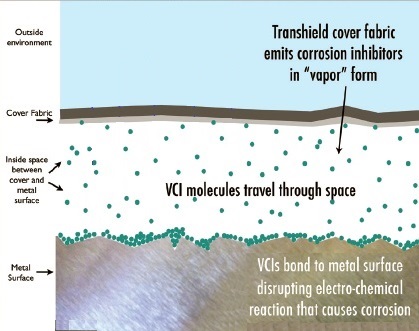A corrosion inhibitor is a chemical substance or combination thereof, which prevents or significantly reduces corrosion without reacting with the environment [1]. A corrosion inhibitor provides protection via three fundamental mechanisms [2]; and they either:
• form an ionic bond on the surface,
• form a film by oxide protection of the surface, or
• change the corrosiveness of an aqueous media.
In 1985 a review of vapor phase corrosion was conducted under a US Army contract [3]. It was reported that vapor corrosion inhibitors (VCIs) were an effective and relatively inexpensive means of corrosion protection in closed environments.
In solid form and at ambient conditions, organic VCIs have sufficient vapor pressure to form a vapor that penetrates complex.
Traditional VCIs include those that are nitrate/nitrite based and when in vapor form and in the presence of moisture they become polarized. Once polarized they are attracted to and form an ionic bond with the surface of the metal. This forms the protective barrier against corrosion [4].
Recent advances in VCI technology have been toward environmentally friendly nitrate/nitrite free formulations which form a barrier between the metal substrate, oxygen, moisture, chlorides and other corrosion accelerants in the atmosphere and also dust and dirt. VCI efficacy can be assessed by conducting a battery of stringent standard test methods [5], [6], [7] and perhaps most importantly field trials.
A practical VCI has an optimal vapor pressure. If the vapor pressure is too low, it will take too long for the concentration of the corrosion inhibitor to reach an effective level. Conversely, if the vapor pressure is too high, the VCI will be consumed quickly and the duration at which the VCI concentration is effective will be limited [3].
Blending VCIs with different vapor pressures provides protection over the short, medium, and long term. Furthermore, multiple formulations provide protection for assets made from a variety of metals.
The rate of corrosion generally increases as temperature rises. Fortunately, as the temperature rises, so does the rate the VCI vaporization. Thus, the environment is self-correcting with fluctuations in temperature [4]. VCI molecules in vapor form provide a self-healing capability since they are attracted to any bare metal.
An elegant engineering solution has been found to manage the VCI concentration when bounded by permeable barriers; compound the VCIs with the adhesive used to create the permeable encapsulation [8].

References
[1] Corrosion: Understanding the Basics, ASM International, Materials Park, OH 2000, pp. 401 [2] Darvina, C. G., Galio, A. F., Corrosion Inhibitors – Principles, Mechanisms and Applications, 2014, http://www.intechopen.com/books/developments-in-corrosion-protection [3] Fodor, G. E., The Inhibition of Vapor-Phase Corrosion: A Review, Belvoir Fuels and Lubricants Research Facility, San Antonio, TX 1985, Interim Report 209 [4] Saji, V., A review on recent patents in corrosion inhibitors, Recent Patents on Corrosion Science, 2010, Vol. 2, pp. 6-12 [5] MIL-STD-3010B Method 4031 – Vapor Inhibiting Ability (VIA) of Volatile Corrosion Inhibitors Materials [6] MIL-STD-3010B Method 3005 – Contact Corrosivity [7] German Method TL8135-002 Testing of Anti-Corrosive Effect of VCI Auxiliary Packaging Materials [8] Todt, G. L., US Patent 5705566